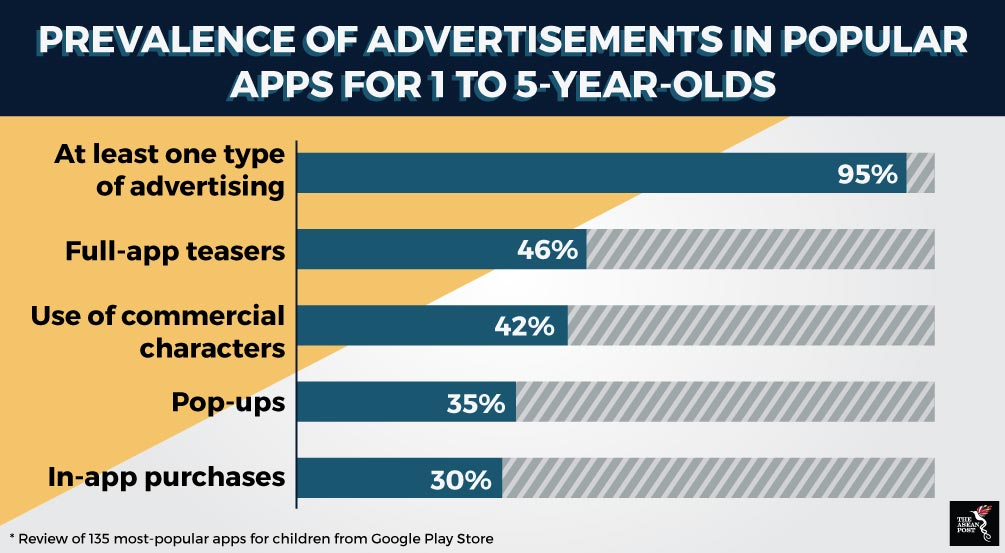Advertisements targeted at young children in today’s digital world are becoming increasingly invasive and prevalent.
Research on 135 of the most popular free and paid apps for children between the ages of one to five in Google’s Play Store last month – some of which were posted under the guise of educational tools – found that 95 percent of these apps contained some form of advertising.
Among the ill-effects of advertising on young children include materialism, obesity and low self-esteem. There are also the constant requests to parents to buy them products which could lead to parent-child conflicts. In addition, prompts to share information such as location – a clear violation of online privacy laws – in some apps means that more awareness has to be raised about a topic which is largely under the radar in Southeast Asia.
A steadily growing middle class combined with an internet penetration rate of 58 percent and a social media penetration rate of 55 percent in 2018 means that more and more parents in the region are giving their children mobile devices without fully understanding the implications.
ASEAN’s population in 2017 was 642.1 million people, according to the ASEAN Secretariat’s ASEAN Statistical Highlights 2018 report. And of that number, 34.5 percent – or 221.5 million people – were below the age of 19.
A study by TotallyAwesome – a kids-safe and compliant digital advertising and content platform – in Indonesia, Malaysia, Singapore, Thailand and Vietnam last year found that 90 percent of children between the ages of four and 12 use social media platforms such as Facebook, Instagram and YouTube – creating a goldmine for advertisers and a headache for parents.
Children do not understand persuasive intent
Unable to easily distinguish between fantasy and reality – and advertising from content – young children are easy targets for children marketers who promote fast food, candy, apparel and toys. Advertisers pay a premium to use YouTube channels because of its ability to host sponsored content which could easily influence young children.
Not only is using young children’s naiveté to sell goods or services unethical, it indirectly turns them into sales promoters; which is why experts recommend restricting advertising directed at children under the age of eight.
The American Psychological Association’s (APA) Task Force on Advertising and Children report in 2014 stated that children under the age of eight are prone to accepting television advertisements as “truthful, accurate and unbiased” – which can lead to unhealthy eating habits.
And because the most common products marketed to young children are sugared cereals, candies, sweets, sodas and snack foods, advertising unhealthy food products to them contributes to poor nutritional habits that may last a lifetime and be a variable in the current epidemic of obesity among kids, added the report.
“Because younger children do not understand persuasive intent in advertising, they are easy targets for commercial persuasion,” said psychologist Brian Wilcox, Ph.D., Professor of Psychology and Director of the Center on Children, Families and the Law at the University of Nebraska and chair of the APA Task Force on Advertising and Children.
The APA report mirrored a study by Angela J. Campbell from the Georgetown University Law Centre in 2017, which said that not only are young children unable to identify sponsored videos as commercials, they lack the ability “to attribute persuasive intent to advertising and to adjust their interpretation of commercial messages consistent with that knowledge.”
“Because they are just developing their cognitive capabilities, children are more trusting than adults and thus, more vulnerable to ‘commercial pitches’ by program hosts,” stated the report titled Rethinking Children's Advertising Policies for the Digital Age.
Campbell added that studies conducted since the 1980s have corroborated the finding that children develop an understanding of persuasive intent at about age eight.
As far back as 1978, the United States’ Federal Trade Commission (FTC) said it considered eight-year-old children as too young to understand the purpose of advertising. FTC later revised the definition to include children six years and younger.
Studies not heeded
However, the lessons learnt more than 40 years ago seem to have fallen on deaf ears, at least on the part of app-developers and internet giants such as Google and YouTube – who continue to host apps and programmes with advertisements catered to young children.
 Source: Advertising in Children's Apps: A Content Analysis
Source: Advertising in Children's Apps: A Content Analysis
A study last month of the 135 most-popular apps for children aged between one to five years from the Google Play Store titled, Advertising in Children's Apps: A Content Analysis, found that all smartphone and tablet apps targeted at toddlers and pre-schoolers have commercial content, often using “manipulative and disruptive” advertising methods.
Published in the Journal of Developmental & Behavioural Paediatrics, the study was the first to look at the advertising children are exposed to when playing with mobile and interactive media.
Ultimately, as advertisers continue to flock to platforms such as YouTube to target their young audiences, it is up to parents to supervise their children’s use of mobile devices and set boundaries on how much time they can spend with it. Educating children, especially those under the age of eight, on advertising will also go a long way in ensuring they are not excessively influenced by it.
Related articles:
Can a sugar tax dent Malaysia’s sweet tooth?
Are Facebook and Google getting too big for us?
